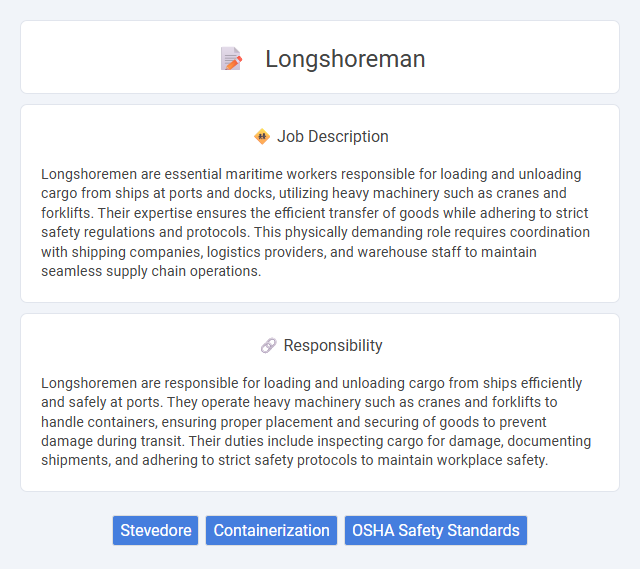
Longshoremen are essential maritime workers responsible for loading and unloading cargo from ships at ports and docks, utilizing heavy machinery such as cranes and forklifts. Their expertise ensures the efficient transfer of goods while adhering to strict safety regulations and protocols. This physically demanding role requires coordination with shipping companies, logistics providers, and warehouse staff to maintain seamless supply chain operations.
Longshoreman jobs likely suit individuals who are physically strong and able to handle demanding manual labor in varying weather conditions. Those with good stamina and the ability to work as part of a team may find this occupation manageable and rewarding. People who prefer sedentary or low-risk environments might struggle with the physical and sometimes hazardous nature of this role.
Qualification
Longshoreman roles require physical strength, stamina, and the ability to operate heavy machinery such as cranes and forklifts. Candidates should possess certifications like OSHA safety training and a valid commercial driver's license (CDL) is often preferred. Experience in cargo handling, knowledge of maritime regulations, and strong teamwork skills contribute significantly to job qualification.
Responsibility
Longshoremen are responsible for loading and unloading cargo from ships efficiently and safely at ports. They operate heavy machinery such as cranes and forklifts to handle containers, ensuring proper placement and securing of goods to prevent damage during transit. Their duties include inspecting cargo for damage, documenting shipments, and adhering to strict safety protocols to maintain workplace safety.
Benefit
The longshoreman job likely offers competitive wages and comprehensive benefits, including health insurance and retirement plans. Opportunities for union membership may enhance job security and collective bargaining power. Access to training programs could improve skills and career advancement prospects.
Challenge
The job of a longshoreman likely presents significant physical and environmental challenges due to heavy lifting, operating machinery, and working in varying weather conditions. There is a probability of facing tight deadlines and coordination issues in busy port environments, which may increase stress levels. Safety hazards are common, requiring constant vigilance to prevent accidents and injuries.
Career Advancement
Longshoreman careers offer substantial opportunities for advancement through skill development and certification in crane operation, cargo handling, and safety compliance. Experienced longshoremen can progress to supervisory roles, such as dock foreman or terminal manager, by demonstrating leadership and operational expertise in port logistics. Continuous training in maritime regulations and equipment technology further enhances promotion prospects within the shipping and logistics industry.
Key Terms
Stevedore
Stevedores, specialized longshoremen, are responsible for loading and unloading cargo from ships, ensuring the safe and efficient handling of freight. They operate heavy machinery, such as cranes and forklifts, and secure cargo to prevent damage during transit. Expertise in maritime logistics and adherence to safety regulations are critical for stevedores in maintaining smooth port operations.
Containerization
Longshoremen play a critical role in containerization by efficiently loading and unloading shipping containers at ports, ensuring smooth cargo transfer between ships and land transportation. Their expertise in operating cranes, forklifts, and other heavy machinery enhances the speed and safety of container handling, minimizing turnaround time for vessels. Skilled coordination among longshoremen directly impacts global supply chains, facilitating timely delivery of goods worldwide.
OSHA Safety Standards
Longshoreman jobs require strict adherence to OSHA safety standards to prevent workplace hazards such as falls, heavy equipment accidents, and hazardous material exposure. Compliance with OSHA regulations includes using personal protective equipment (PPE), proper signaling during cargo handling, and regular safety training to minimize risks. Employers must ensure that dock operations meet OSHA guidelines for load securing, equipment maintenance, and emergency procedures to protect workers' health and safety.
 kuljobs.com
kuljobs.com